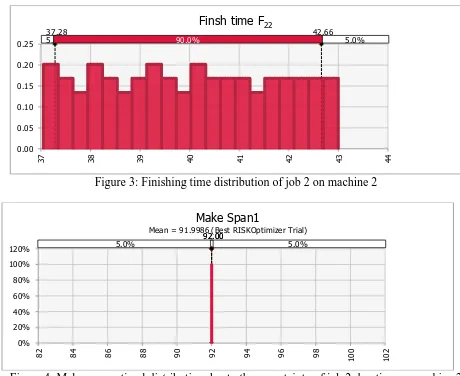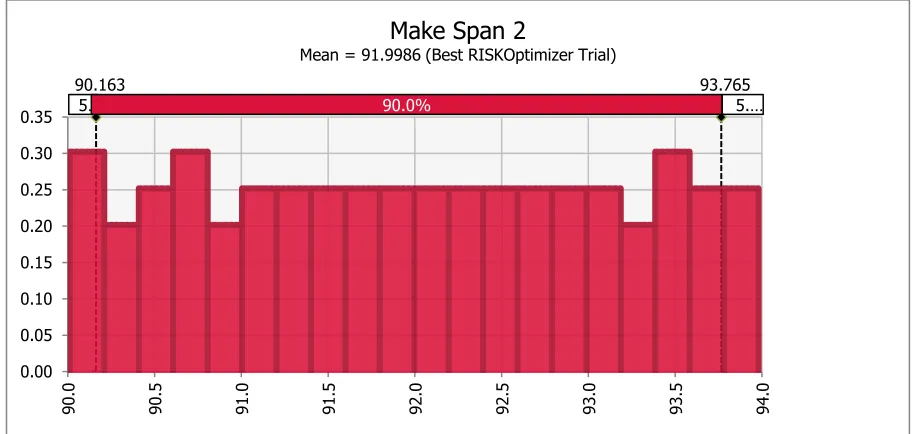Http://www.ijetmr.com©International Journal of Engineering Technologies and Management Research [73]
JOB-SHOP SCHEDULING OPTIMIZATION WITH STOCHASTIC
PROCESSING TIMES
Jaber S. Alzahrani *1
*1 Department of Industrial Engineering, Engineering College at Alqunfudah, Umm Al-Qura
University, Saudi Arabia
Abstract:
In this study, a job shop scheduling optimization model under risk has been developed to minimize the make span. This model has been built using Microsoft Excel spreadsheets and solved using @Risk solver. A set of experiments have been also conducted to examine the accuracy of the model and its effectiveness has been proven.
Keywords: JSSP; Genetic Algorithm; Optimization; @Risk.
Cite This Article: Jaber S. Alzahrani. (2019). “JOB-SHOP SCHEDULING OPTIMIZATION WITH STOCHASTIC PROCESSING TIMES.” International Journal of Engineering
Technologies and Management Research, 6(1), 73-83. DOI: 10.29121/ijetmr.v6.i1.2019.347
1. Introduction
Http://www.ijetmr.com©International Journal of Engineering Technologies and Management Research [74]
Finally, Alcaide et al. [15] have studied open shop scheduling problems of random processing times, breakdowns and repair times, where the expected makespan must be minimized. They developed a general dynamic procedure that converts any problem into a set of scheduling problems without breakdowns.
In the recent literature, two new criteria have been brought to the attention of researchers for their consideration: robustness and stability [1]. Robustness means that schedule performance is still acceptable when something unforeseen happens. However, Stability means that schedule does not deviate significantly due to disruption and revision. In general, there are two methodologies to deal with the uncertainty in a scheduling environment: proactive and reactive scheduling. Incorporating the knowledge of uncertainty at the decision stage, proactive approaches focus on generating more robust predictive schedules to minimize the effects of disruptions. On the other hand, reactive scheduling algorithms are implemented at execution time to adjust the schedule according to the real-time situation when the uncertainty is realized, or disruptions occur. This paper proposes a proactive approach to generate a long-term initial schedule under uncertainty to jointly determine the production planning and preventive maintenance to simultaneously optimize system bi-objective of robustness and stability.
Zhiqiang Lu et al. [2] addressed the problem of finding a robust and stable schedule for a single machine with availability constraints. The machine suffers unexpected breakdowns and follows the Weibull failure function.
The mission of the scheduling process is to optimally allocate the suitable equipment to perform the required jobs over a period to achieve the business goals. Therefore, many efforts have been devoted to solve most optimal Job Shop Scheduling Problems (JSSP), as most of the researches aimed at minimizing the maximum completion time. JSSP is an NP-hard problem; so, it is difficult to find an exact solution in a reasonable computation time [16]. Number of optimization methods have been developed to solve JSSP, Tabu Search [17, 18], Simulated Annealing [19, 20], Genetic Algorithms [21, 22], Particle Swarm Optimization [23, 24], Ant Colony Optimization [25, 26], differential evolution algorithm [27], Memetic Algorithm [28], Mathematical Programming [29, 30], and Goal Programming [31].
Genetic Algorithm has the advantage to solve scheduling problems. It can reach optimal or sub-optimal solutions. It has gained the advantage of getting the global optimization solution in a huge population.
Risk analysis in @RISK is known as a quantitative method that seeks to determine the probability distributions of outcomes resulting from decisions. In general, the techniques in a @RISK risk analysis encompass four steps:
1) Developing a Model. Define your problem or situation in an Excel model.
2) Identifying Inputs and Outputs. Determine uncertain inputs in the model, specify their possible values with probability distributions and identify the important outputs you want to analyze.
Http://www.ijetmr.com©International Journal of Engineering Technologies and Management Research [75]
The first three steps of @RISK help in providing a powerful and flexible set of tools in Excel to facilitate model building and risk analysis. The results generated by @RISK can then be used by a decision maker to choose a course of action.
The aim of this paper is to present a job shop scheduling (JSS) optimization model under risk is developed to minimize the makespan. The model has been built using the Microsoft Excel spreadsheets and solved using @Risk.
2. Problem Description and Assumptions
The goal of this model is to Solve a JSS problem where spreadsheet-based commercial genetic algorithm solver “@Risk” [32] is used to optimize the makespan function in below mentioned Equation 4.
Classical Job Shop Scheduling Problems (JSSP) considers the allocation of n jobs to m different machines or equipment. Each job has to undergo multiple operations in various equipment, with its own set of processing times and routing characteristics. The processing time of each job on an equipment Phj is known as well as the due date for each job Dj.
The model assumes the following:
• The processing times are stochastic;
• Each job has its own due date;
• Each job will not visit “undergone” by the same equipment twice;
• All jobs are ready for processing at time zero;
• All equipment are available at time zero;
• Each equipment can process only one job at a time;
• Only one job can be processed by an equipment at any instant in time;
• Set-up time for any operation is included in the processing time;
• The required transportation time for the movement of jobs between equipment is assumed to be negligible;
• The operation couldn’t be interrupted;
• There are no precedence constraints among operations of different jobs.
3. Model Formulation
Parameters
N: Number of jobs M: Number of machines
Pji: Processing time for job j on m/c, j = 1, 2, …, N and i = 1, 2, …, M Dj: Due date of job j, j =1, 2, …, N
SEQ: Processing sequence array
NUMT: No. of machines (tasks) for each job NUMJ: No. of jobs per machine J
Http://www.ijetmr.com©International Journal of Engineering Technologies and Management Research [76] Decision Variables
Cj: Completion time of job j
Sji: Starting time of job j on machine i Fji: Finishing time of job j on machine i
Pji: Processing time for job j on m/c, j = 1, 2, …, N and i = 1, 2, …, M
3.1.Objective Functions
The objective of this model is to minimize the makespan which has been defined in Equation 1.
Makespan = MAX (C𝑗), ∀ j ∈ N (1)
3.2.Constraints
1) Disjunction constraints (to avoid overlapping between tasks)
(Shi− Shj) ≥ Phj− M Yhij , ∀i, j ∈ N, ∀h ∈ M (2)
(Shj− Shi) ≥ Phi− M (1 − Yhij) , ∀i, j ∈ N, ∀h ∈ M (3)
2) Conjunction constraints (to satisfy operational precedence)
∑ℎ∈𝑀(𝑆𝑆𝐸𝑄(𝑗,𝑙),𝑗+ 𝑃𝑆𝐸𝑄(𝑗,𝑙),𝑗)≥ ∑ℎ∈𝑀𝑆𝑆𝐸𝑄(𝑗,𝑙+1),𝑗, ∀ 𝑗 ∈ 𝑁, ∀𝑙 ∈ 𝑀 − 1 (4)
4. Computational Results and Analysis
In this section, the results of the proposed model application are introduced. In consequence, the model has been solved using @Risk optimizer which operates in an Intel® Core™ i3-2310M CPU @2.10 GHz (3 GB of RAM). The GA parameters include; population size N = 50, number of generations G = 40,000, probability of crossover Pc = 0.5, and probability of mutation Pm = 0.1.
To avoid doubt, it is meaningful to distinguish between the terms “trials” and “iterations” in the RISK Optimizer process. The overall process involves a sequence of “trials,” where a given set of adjustable cell values is tested on each trial. For the evaluation of the target cell (and the constraint cells) for a trial, a standard @RISK simulation is run for a specified number of “iterations.” This distinction helps in understanding why RISK Optimizer can take some time. For example, it might require 1000 trials to converge to optimality, and each of these trials might require a 500-iteration simulation. There will be a lot of computer calculation, especially for complex models.
As in traditional optimizers, constraints can be entered in RISKOptimizer. When the value of the constrained cell does not change during a simulation, the constraint is called non-probabilistic. Otherwise, it is called probabilistic. A probabilistic constraint is based on a statistic of the distribution of the cell’s values, such as “the mean of A1 <= 100.” RISKOptimizer calculates the statistic at the end of each simulation to decide whether the constraint is satisfied or not.
Http://www.ijetmr.com©International Journal of Engineering Technologies and Management Research [77]
Table 1: Job’s processing sequences
Job Processing Sequence (Duration)
J1 M1 (19) M3 (10) M4 (19)
J2 M1 (10) M2 (30) M3 (18) M4 (10) J3 M4 (15) M3 (18) M2 (31)
J4 M2 (14) M3 (10) M4 (20) M1 (19) J5 M1 (15) M3 (16)
Initially, the problem has been solved as a deterministic to set the base of comparison and discussion for the stochastic solutions. The Gantt chart of the deterministic case is shown in Figure 1.
Figure 1: Gantt chart of the makespan objective
In Figure 1, the dotted red line represents the critical path operations which include operations O42, O43, O13, O23, O33, and O53.
It may be noticed in the Gantt chart that there is a slack time of 18 units of time after finishing the second operation of the second job on the second machine. So that, the effect of changing the processing time of this operation into stochastic for the optimal makespan will be studied.
The duration P22 is assumed to follow a uniform distribution among a minimum value 27, a maximum value 33 and random value as shown in Figure 2.
M1
M2
M3
M4
76-92
0-31 31-50 50-69 76-87
10-30 30-40 40-58 58-76
29-44 50-64
0-10 10-40 58-73
0-10 10-29
Http://www.ijetmr.com©International Journal of Engineering Technologies and Management Research [78]
Figure 2: Duration distribution of job 2 on machine 2
Figure 3, shows operation finishing time in which it has a uniform distribution. As this operation is not a critical one form those shown in Figure 1, the optimal makespan remains the same of about 92. It was in the deterministic case as shown in Figure 4.
Figure 3: Finishing time distribution of job 2 on machine 2
Figure 4: Makespan optimal distribution due to the uncertainty of job 2 duration on machine 2
27.28 32.66
5.0% 90.0% 5.0%
4.7% 89.6% 5.7%
0.00 0.05 0.10 0.15 0.20 0.25
26 27 28 29 30 31 32 33 34
Duration P22
Comparison with Uniform(27,33)
37.28 42.66
5… 90.0% 5.0%
0.00 0.05 0.10 0.15 0.20 0.25
37 38 39 40 41 42 43 44
Finsh time F22
92.00 92.00
5.0% 5.0%
0% 20% 40% 60% 80% 100% 120%
82 84 86 88 90 92 94 96 98 100 102
Make Span1
Http://www.ijetmr.com©International Journal of Engineering Technologies and Management Research [79]
It may be noticed in the Gantt chart in Figure 1 that the second operation of job 5, machine 3 is one of the critical operations. Therefore, this experiment has to study the effect of changing the processing time of this operation into stochastic for the optimal makespan. The duration P53 of this critical operation is assumed to follow a uniform distribution of a minimum value by 14, a maximum value by 18 and random value as shown in Figure 5.
Figure 5: Duration distribution of job 5 on machine 3
Figure 6 shows the operation finishing time in which it has a uniform distribution shape. As this operation is one of the critical operations, the optimal makespan will not have a single value as in the previous case but it will have a probabilistic distribution of uniform shape as shown in Figure 7.
Figure 6: Finishing time distribution of job 5 on machine 3
14.163 17.765
5.0% 90.0% 5.0%
4.1% 90.1% 5.9%
0.00 0.05 0.10 0.15 0.20 0.25 0.30 0.35 13 .5 14 .0 14 .5 15 .0 15 .5 16 .0 16 .5 17 .0 17 .5 18 .0 18 .5
Duration time P53
Comparison with Uniform(14,18)
90.163 93.765
5… 90.0% 5.…
0.00 0.05 0.10 0.15 0.20 0.25 0.30 0.35 90 .0 90 .5 91 .0 91 .5 92 .0 92 .5 93 .0 93 .5 94 .0
Http://www.ijetmr.com©International Journal of Engineering Technologies and Management Research [80]
Figure 7: Makespan optimal distribution due to uncertainty of job 5 duration on machine 3
In this experiment, the processing times of all jobs are assumed to be stochastic and follow a normal distribution. Since the normal distribution has two parameters, the standard deviation is given as a ratio to the mean; the ratio of the standard deviation to the mean is known as the variability and assumed to be 10%; N (µij, σij) where σij equals 10 % of µij.
Figure 8 shows the distribution of resulted optimal makespan by 10% variability. In addition, Figure 9 depicts the correlation between the resulted makespan and all other uncertain processing times in which it is obvious that the most correlated operations to the makespan are those of O53 and O42 which represent the first and last operations of the critical path.
Figure 8: Makespan optimal distribution due to 10% variability
90.163 93.765
5… 90.0% 5.…
0.00 0.05 0.10 0.15 0.20 0.25 0.30 0.35 90 .0 90 .5 91 .0 91 .5 92 .0 92 .5 93 .0 93 .5 94 .0
Make Span 2
Mean = 91.9986 (Best RISKOptimizer Trial)
103.27 108.54
5.0% 90.0% 5.0%
Http://www.ijetmr.com©International Journal of Engineering Technologies and Management Research [81]
Figure 9: Correlation Coefficients (Spearman Rank)
In Figure 10, the change in makespan mean across a range of uncertain processing times is studied and presented. It is noticed that duration P53 has the greatest effect on the makespan which may assure the last conclusion in Figure 9.
Figure 10: Change in makespan mean Across Range of Input Values
5. Conclusion
The JSS optimization problem has been successfully solved to optimize the makespan under the situation of the uncertainty of the processing times of all jobs.
A developed JSS optimization model has been built using the Microsoft Excel spreadsheets and solved using @Risk solver. A set of four experiments have been conducted to solve the problem
-0.08 -0.07
-0.06
-0.05 -0.04 -0.03
-0.01
1.00
0.16
0.05
0.03
0.01 0.01 0.01
-0
.2 0.0 0.2 0.4 0.6 0.8 1.0 1.2
Coefficient Value
103 104 105 106 107 108 109
0% 10% 20% 30% 40% 50% 60% 70% 80% 90%
10
0%
Ma
ke
Spa
n
Input Percentile%
P53
Http://www.ijetmr.com©International Journal of Engineering Technologies and Management Research [82]
using deterministic processing times, uncertain non-critical operation processing time, uncertain critical operation processing time and uncertainty of all operations processing times.
Finally; the accuracy of the model and its effectiveness have been proven through the analysis of the obtained results.
References
[1] S. Goren and I. Sabuncuoglu, "Robustness and stability measures for scheduling: single-machine environment," IIE Transactions, vol. 40, pp. 66-83, 2008.
[2] Z. Lu, W. Cui, and X. Han, "Integrated production and preventive maintenance scheduling for a single machine with failure uncertainty," Computers & Industrial Engineering, vol. 80, pp. 236-244, 2015.
[3] M. Singer, "Forecasting policies for scheduling a stochastic due date job shop," International Journal of Production Research, vol. 38, pp. 3623-3637, 2000.
[4] D. Golenko-Ginzburg, S. Kesler, and Z. Landsman, "Industrial job-shop scheduling with random operations and different priorities," International journal of production economics, vol. 40, pp. 185-195, 1995.
[5] D. Golenko-Ginzburg and A. Gonik, "Using “look ahead” techniques in job-shop scheduling with random operations," International journal of production economics, vol. 50, pp. 13-22, 1997. [6] D. Golenko-Ginzburg and A. Gonik, "Optimal job-shop scheduling with random operations and
cost objectives," International Journal of Production Economics, vol. 76, pp. 147-157, 2002. [7] Y. Yoshitomi, "A genetic algorithm approach to solving stochastic job‐shop scheduling problems,"
International Transactions in Operational Research, vol. 9, pp. 479-495, 2002.
[8] Y. Yoshitomi and R. Yamaguchi, "A genetic algorithm and the Monte Carlo method for stochastic job‐shop scheduling," International Transactions in Operational Research, vol. 10, pp. 577-596, 2003.
[9] R. Tavakkoli-Moghaddam, F. Jolai, F. Vaziri, P. Ahmed, and A. Azaron, "A hybrid method for solving stochastic job shop scheduling problems," Applied mathematics and computation, vol. 170, pp. 185-206, 2005.
[10] T.-C. Lai, Y. N. Sotskov, N. Y. Sotskova, and F. Werner, "Optimal makespan scheduling with given bounds of processing times," Mathematical and Computer Modelling, vol. 26, pp. 67-86, 1997.
[11] T. Lai and Y. N. Sotskov, "Sequencing with uncertain numerical data for makespan minimisation," Journal of the Operational Research Society, vol. 50, pp. 230-243, 1999.
[12] T.-C. Lai, Y. N. Sotskov, N. Sotskova, and F. Werner, "Mean flow time minimization with given bounds of processing times," European Journal of Operational Research, vol. 159, pp. 558-573, 2004.
[13] P. B. Luh, D. Chen, and L. S. Thakur, "An effective approach for job-shop scheduling with uncertain processing requirements," IEEE Transactions on Robotics and Automation, vol. 15, pp. 328-339, 1999.
[14] K. Neumann and W. G. Schneider, "Heuristic algorithms for job‐shop scheduling problems with stochastic precedence constraints," Annals of Operations Research, vol. 92, pp. 45-63, 1999. [15] D. Alcaide, A. Rodriguez-Gonzalez, and J. Sicilia, "A heuristic approach to minimize expected
makespan in open shops subject to stochastic processing times and failures," International Journal of Flexible Manufacturing Systems, vol. 17, pp. 201-226, 2005.
[16] M. R. Garey, D. S. Johnson, and R. Sethi, "The complexity of flowshop and jobshop scheduling," Mathematics of operations research, vol. 1, pp. 117-129, 1976.
Http://www.ijetmr.com©International Journal of Engineering Technologies and Management Research [83] [18] A. Ponsich and C. A. C. Coello, "A hybrid differential evolution—tabu search algorithm for the solution of job-shop scheduling problems," Applied Soft Computing, vol. 13, pp. 462-474, 2013. [19] H. R. Lourenco, "Job-shop scheduling: Computational study of local search and large-step
optimization methods," European Journal of Operational Research, vol. 83, pp. 347-364, 1995. [20] M. Faccio, J. Ries, and N. Saggiorno, "Simulated annealing approach to solve dual resource
constrained job shop scheduling problems: layout impact analysis on solution quality," International Journal of Mathematics in Operational Research, vol. 7, pp. 609-629, 2015.
[21] R. Cheng, M. Gen, and Y. Tsujimura, "A tutorial survey of job-shop scheduling problems using genetic algorithms—I. Representation," Computers & industrial engineering, vol. 30, pp. 983-997, 1996.
[22] Y. Wang, "A new hybrid genetic algorithm for job shop scheduling problem," Computers & Operations Research, vol. 39, pp. 2291-2299, 2012.
[23] D. Sha and C.-Y. Hsu, "A hybrid particle swarm optimization for job shop scheduling problem," Computers & Industrial Engineering, vol. 51, pp. 791-808, 2006.
[24] T.-L. Lin, S.-J. Horng, T.-W. Kao, Y.-H. Chen, R.-S. Run, R.-J. Chen, et al., "An efficient job-shop scheduling algorithm based on particle swarm optimization," Expert Systems with Applications, vol. 37, pp. 2629-2636, 2010.
[25] K.-L. Huang and C.-J. Liao, "Ant colony optimization combined with taboo search for the job shop scheduling problem," Computers & operations research, vol. 35, pp. 1030-1046, 2008.
[26] A. Udomsakdigool and V. Kachitvichyanukul, "Multiple colony ant algorithm for job-shop scheduling problem," International Journal of Production Research, vol. 46, pp. 4155-4175, 2008. [27] P. Quanke, W. Ling, and G. Liang, "Differential evolution algorithm based on blocks on critical path for job shop scheduling problems," Journal of Mechanical Engineering, vol. 46, pp. 182-188, 2010.
[28] L. Gao, G. Zhang, L. Zhang, and X. Li, "An efficient memetic algorithm for solving the job shop scheduling problem," Computers & Industrial Engineering, vol. 60, pp. 699-705, 2011.
[29] M. S. Al-Ashhab, Munshi, S., Oreijah, M., & Ghulman, H., "Job Shop Scheduling Using Mixed Integer Programming," International Journal of Modern Engineering Research, vol. 7, p. 7, 2017. [30] K. R. Baker and B. Keller, "Solving the single-machine sequencing problem using integer
programming," Computers & Industrial Engineering, vol. 59, pp. 730-735, 2010.
[31] M. Al-Ashhab, "Multi-Objective Job Shop Scheduling Using a Lexicographic Procedure."
[32] N. Palisade, "Guide to Evolver–The genetic algorithm solver for Microsoft Excel," ed: Newfield, NY: Palisade Corporation, 1998.
*Corresponding author.




